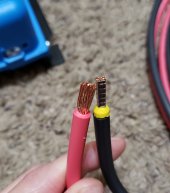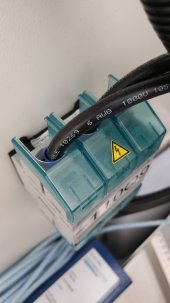It seems most common practice is to tighten the charge controller's bolts onto the bare wire strands. Is there any advantage/disadvantage to sealing the PV cable strands in ferrule caps before tightening them into the charge controller? Seems to be standard practice in Europe to encase stranded wire in a ferrule for such connections. Thoughts?
You are using an out of date browser. It may not display this or other websites correctly.
You should upgrade or use an alternative browser.
You should upgrade or use an alternative browser.
Ferrules on PV cables or bare strands?
- Thread starter max4296
- Start date
John Frum
Tell me your problems
- Joined
- Nov 30, 2019
- Messages
- 15,233
I like ferrules and I am in North America.It seems most common practice is to tighten the charge controller's bolts onto the bare wire strands. Is there any advantage/disadvantage to sealing the PV cable strands in ferrule caps before tightening them into the charge controller? Seems to be standard practice in Europe to encase stranded wire in a ferrule for such connections. Thoughts?
Putting fine stranded wire into a mechanical lug without a ferrule often risks an errant strand making a short circuit with the next lug.
Also the stranded wire generally doesn't get as chewed up when its "boot laced".
One downside that I have seen is some mechanical lugs are small enough that you have to go down a wire size in order to put a ferrule on the wire.
This conflicts with my general policy of using the largest wire that fits in the mechanical lug.
MrNatural22
?SW sunshine =⚡️⚡️lit up thru the darkness✌️

do crimped ferrules increase resistance
Do ferrules make a lower or higher resistance connection?
Also depends on the charge controller. Some are designed to properly tighten down even on fine strand cable without damaging it. If yours simply has a screw with no plate that pushes against the wire then you should use a ferrule on it.
Ferrules rule for rounding up feral wire strands. See what I did there ?
Seriously though, there is a YouTube video out there of someone who used an IR camera on their connections pre and post ferrule installation and the difference was remarkable. I’m a fan of using them.
Seriously though, there is a YouTube video out there of someone who used an IR camera on their connections pre and post ferrule installation and the difference was remarkable. I’m a fan of using them.
Split bolts have a floating piece of metal that goes between the two wires. This works because the inside walls of a split bolt are parallel, unlike a mechanical lug. Has anyone seen a mechanical lug with a standard curved bottom and parallel sides above the bottom that would allow for a split boaty floating piece of metal? Wire would have to be of a volume sized large enough so the floating plate couldn't bottom on the curved part of the lug.
So it seems like a good rule of thumb is to use a ferrule, except in situations where your equipment is specifically designed to accept bare strand connection.
I also learned, per MrNatural's link above, that you need a special tool to crimp ferrules
I also learned, per MrNatural's link above, that you need a special tool to crimp ferrules
John Frum
Tell me your problems
- Joined
- Nov 30, 2019
- Messages
- 15,233
Depends on the size of the ferrule and the shape of the mechanical lug.So it seems like a good rule of thumb is to use a ferrule, except in situations where your equipment is specifically designed to accept bare strand connection.
I also learned, per MrNatural's link above, that you need a special tool to crimp ferrules
If the mechanical lug has a rounded contact surface I find it best to let the screw conform the ferrule to the contact surface.
If its a clamp style lug then the 4 sided crimp works best.
I also learned, per MrNatural's link above, that you need a special tool to crimp ferrules
For 8 AWG and smaller I use this :
crossy
Solar Addict
I only use ferrules on finely stranded cable, I have both square and hex crimpers for up to 16mm2, which to use depends on the clamp it's going in.
Which connection do you think is a stronger repeatable connection?bare strands. most PV controller terminals aren't strong enough to deform a 10awg ferrule for a good connection
before and after connection. which one do you think has more surface area to the terminal
Also, your wire is multi stranded conductors, not fine wire flexible conductors.
wattmatters
Solar Wizard
I'm going to put ferrules on my AIO connections when I redo the wiring when I finish getting my PV connected.
I'm not convinced all of the wire strands are going where they should, especially as the terminal location is a bit awkward. With a ferrule it much easier to feed the wire into the terminal and know for sure it is secure.
I'm not convinced all of the wire strands are going where they should, especially as the terminal location is a bit awkward. With a ferrule it much easier to feed the wire into the terminal and know for sure it is secure.
Here is a pretty good article on ferrules: https://hackaday.com/2018/04/12/to-ferrule-or-not-to-ferrule/
"fine" strand usually consists of strands of around 30AWG wire. So a 6AWG cable would have around 250 strands.bare strands. most PV controller terminals aren't strong enough to deform a 10awg ferrule for a good connection
before and after connection. which one do you think has more surface area to the terminal
In my install, if it didn't have a ring terminal on it then it got a ferrule. My thermostat board had teeny tiny terminals that weren't big enough for ferrules.
How often are you redoing your connections? Fine stranded wire would be treated the same. You want as much contact area between the terminal and the conductor. A thick ferrule prevents that.Which connection do you think is a stronger repeatable connection?
Also, your wire is multi stranded conductors, not fine wire flexible conductors.
If you're worried about a loose strand shorting to another terminal then slow down and stop throwing wires into terminal blocks.
Everything in here has a ferrule. Even the thicker wires, because they have appropriately sized terminals.
Attachments
You want as much contact area between the terminal and the conductor. A thick ferrule prevents that.
Is that what you meant to write? If so, I'm not sure what you mean.
as you tighten the terminal you want it to crush the ferrule a bit. that way you get more points of contact for current to flow. look at the before and after pictures I posted above. the ferrule looks the same because the terminal on the SCC is anemicIs that what you meant to write? If so, I'm not sure what you mean.
Similar threads
- Replies
- 4
- Views
- 972






